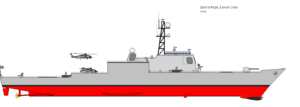Lancer Class
Lancer Class Cruiser
| |
| Class overview | |
|---|---|
| Name: | Lancer Class Cruiser |
| Operators: | Spirit Of Hope Navy |
| Built: | 1985-1992 |
| In service: | April 1987-present |
| Planned: | 15, reduced to 11 |
| Completed: | 11 |
| Active: | 11 |
| General characteristics | |
| Class and type: | Lancer Class Cruiser |
| Displacement: | 17,500 tons |
| Length: | 666ft (202m) |
| Beam: | 75ft (23m) |
| Draft: | 23ft (7m) |
| Installed power: | twin Pressurized Water Nuclear Reactors |
| Propulsion: | two reversible pitch propellers |
| Speed: | 30 knots |
| Complement: | 483 |
| Armament: |
|
| Aircraft carried: | 2 SH-60 |
| Aviation facilities: | Stern hangar with capacity of two small helicopters or one medium size helicopter |
The Lancer class of nuclear guided missile cruisers is a class of warship in the Spirit of Hope Navy, which primarily serve as escorts for the aircraft carriers of the Spirit of Hope Navy, though they will at times they will operate independently or with destroyer formations. The VLS cells installed on all Lancer class cruisers allow them to carry a wide verity of weapons, allowing their armaments to be tailored to the mission at hand, including anti air missiles, rocket launched torpedoes, anti ship weapons, and cruise missiles. The Lancer class has demonstrated the ability to conduct anti ballistic missile and anti satellite missions.
History
In 1978 with the advent of VLS missile cells and ongoing advances in radar and electronics the Spirit of Hope Navy conducted a study of how it's fleet should be updated. The study noted that the existing nuclear cruiser fleet, largely constructed in the early 60's, were coming up on their refueling point and were not well designed to be retrofitted with VLS cells. The conclusion was that it would be more economical to produce a new class designed around the new technologies than to refuel and re equip the existing fleet.
In February of 1979 the Spirit of Hope Navy submitted the request for 20 of the new cruiser design to the House of Commons, in May of 1979 the House of Commons requested a re design after the Spirit of Hope Army stated the 1979 design would not meet shore bombardment requirements needed to support amphibious operations. The Navy made minor alterations to the cruiser design, adding a second 100mm gun and increasing shell storage by 150%, and submitted the new design in January of 1980. The Army again stated that the design did not meet shore bombardment requirements, and requested a re design. The Navy refused a new re design, stating any further increases to shore bombardment capability would come at the expense of anti air or anti submarine capabilities that were unacceptable give the ships intended purpose.
In response the Army proposed their own design for a cruiser that did meet their needs, which was rejected by the Navy as it failed to meet any of the Navies needs. For the next two years the House of Commons held hearings on the cruiser design, and conducting their own study on how the future fleet should be developed. Finally in 1983 the House of Commons passed a budget authorizing 15 of the original nuclear cruiser design, and 5 gunfire support cruisers, which would become the Fielding Class Cruiser. After a minor re design production began on the first Lancer Class Cruiser in 1985.
In 1990 the House of Commons reduced the order to 11 Lancer class cruisers and 2 Fielding class cruisers.
Design
The Lancer class was designed around modern phased array radars and VLS missile tubes, using then modern computers to fully integrate tracking and targeting. As the primary mission of the cruiser was to escort nuclear aircraft carriers, the Lancer class was made nuclear powered as well. This meant that the Lancer Class could maintain sprint speeds alongside the carrier almost indefinitely, which would not be possible otherwise.
The Lancer class uses two reactors each with a maximum thermal output of 150 megawatts, combined with two steam turbines, driving two shafts, for a total of 70,000 shaft horsepower. This gives the Lancer Cruisers a maximum speed of 30 knots.
The Lancer Class Cruisers are armed with a 100mm gun, the same basic design as used on frigates and destroyers of the Spirit of Hope Navy, it has no expanded magazine capacity over the smaller classes, as an emphasis was placed on missile capacity. With 160 VLS cells the Lancer Class can be loaded with a variety of different missiles, including anti air, anti surface, rocket launched torpedoes, and cruise missiles. In addition the Lancer class has two Goalkeeper 30mm CIWS, and can mount four heavy machine guns for defense against small boats.
There is a hanger in the rear with enough space for a complement of two SH-60 ASW helicopters, Lancer class cruisers have demonstrated the ability to land and store larger aircraft, and a third aircraft can be kept on the flight deck for limited amounts of time.
